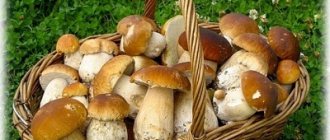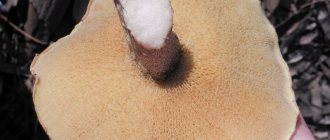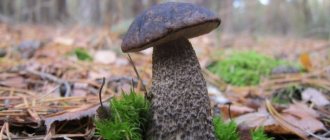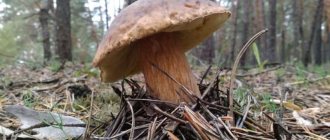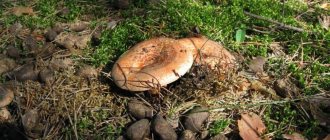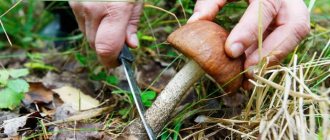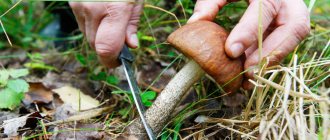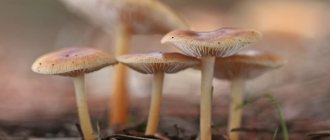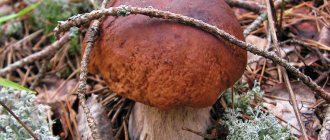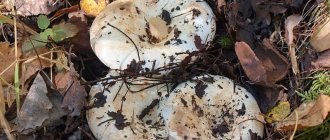The boletus got its name for its interesting features: the mushroom cap is covered with a mucous, sticky skin that is difficult to remove, especially if it gets wet. Another characteristic feature of some representatives of this species is the presence of rings on the leg. Are there boletus with a “skirt”, and can they be eaten?
Features of a pine forest
In a pine forest, in addition to pines, deciduous trees, spruce and other conifers can grow. Sometimes linden, oak, birch, and aspen are present. Such forests are common in forest and forest-steppe zones. It performs a soil-protective and sanitary-hygienic role. Pines are frost-resistant trees and also tolerate heat well. The tree grows quickly and bears fruit due to constant deforestation and fires.
The amount of precipitation and air humidity in the forest is much higher than in urban areas. Closely located fields have the same property.
Developed and powerful roots strengthen mountain slopes. The forest retains fresh water. Thanks to the roots, mudflows and avalanches are reduced.
High quality wood is obtained from pine trees, and the resin from the trunk is used in medicine. In addition, the forest is rich in nut bushes, edible mushrooms and berries.
Here you can collect the following mushrooms: late, granular, marsh boletus; autumn honey mushrooms; goats, various types of russula, talkers and greenfinches; rows, white mushrooms, saffron milk caps, umbrella mushrooms, purple moths, Polish mushrooms, lines, morels, prickly puffballs, pine boletus varieties, truffles, truffles.
In addition to edible mushrooms, several types of fly agaric, gall mushroom, pale pellets and false honey mushrooms are often found in the pine forest.
Edible species
Experienced mushroom pickers know where mushrooms grow. Much depends on the climate and the substances that prevail in the area.
Mushrooms are found on the ground, on pine trunks and on rocks. The most common representatives of all mushrooms that can be found in a pine forest:
Late oiler
This mushroom is often called autumn, yellow, ordinary. The cap is convex, brownish in color; The skin is slimy and comes off easily. The tubes are attached to the stem, pale yellow in color. The stem of the cap is lemon-colored, brown closer to the root, and cylindrical in shape. It has a ring on the stem, which is different from the red oiler.
The flesh is soft and juicy in the cap, fibrous in the stem, white in color, turning yellow when cut. Can be found on sandy soils alone or in groups. Duration from the end of May to November.
Butterflies appear 2-3 days after the rains, the air temperature should not exceed 20 degrees. Sometimes insects attack mushrooms in the summer; in the fall, boletus mushrooms are not eaten by worms.
In terms of the content of useful substances, the late oiler is ahead of the boletus.
Autumn honey fungus
Honey fungus is found under pine trees, on the ground. They grow in large groups, capturing vast territories. The cap is convex, the edges can bend upward. The color comes in different colors, most often yellow-brown. With age, the surface bursts and forms dark scales. The leg is white, cylindrical in shape. The pulp is fibrous, dense, white; After collection it requires heat treatment.
The smell is mushroom, but the taste does not feel any mushroom qualities, it is more like cheese, a little astringent.
Autumn honey fungus grows on wood from July to November. The largest harvest can be harvested in August. This type of honey agaric is very similar to the dark, thin-legged, bulbous-legged drying honey agaric.
Greenfinch
Greenfinch belongs to one of the types of rows. Its name comes from its green-yellow body color. They grow in middle-aged forests both in groups and individually.
They do not like heat and light, so they grow in the shade inside the forest, perhaps under fallen pine needles or under the soil. The greenfinch has a straight leg that widens downward.
The mushroom grows in the sand. The surface of the greenfinch itself is sticky, so the mushroom is always dirty and needs to be washed thoroughly. Greenfinch is contraindicated for people with poor blood clotting, allergic reactions, kidney disease, and during pregnancy. Greenfinches are found in August and finish growing in September. They grow one at a time or in groups of eight mushrooms. The mushroom is rarely wormy.
White pine mushroom
The cap initially takes the shape of a hemisphere, then becomes convex and brown-red in color. The leg is large, swollen, slightly lighter in color than the cap, covered with a red mesh pattern.
The mushroom has high taste qualities. It is used in almost all dishes. The taste is mild, the aroma is mushroom. The pulp is milky in color and turns pink when cut. It is collected in June and finished in October.
Due to its rarity, it is treated with caution. Can be confused with poisonous mushrooms, including satanic and gall mushrooms.
The surface is smooth, sometimes uneven, grooved or covered with tubercles. The skin separates poorly, the color is variable - it changes color to light chestnut or acquires a purple hue, the tone is lighter along the edges.
There are large mushrooms, but young ones need to be collected, since adults are affected by various larvae.
The fox is real
Chanterelles have a unique structure, which makes it difficult to confuse them with another poisonous mushroom. Grows in damp places. After the rains, large groups of chanterelles appear.
The mushroom is small and orange. The funnel-shaped cap is covered with folds from below and smoothly passes into the stem. The skin is difficult to separate from the dense pulp. Chanterelle has a pleasant fruity smell. The pulp is dense and elastic.
Found in mosses, grows from June to October. Outwardly it resembles the yellow hedgehog, but the latter has a non-fused cap and stem. It has a double - a false fox. They differ in color and shape.
Ryzhik
This species is called true, pine, autumn camelina. The cap is thick, fleshy, funnel-shaped, then becomes flat, the edges are curved, and orange in color. The pulp is brittle, orange, and turns greenish when cut. The stem is cylindrical, the color is the same as the cap. The flesh of the leg is fragile. The smell is pleasant, the taste is pungent.
Used for pickling and salting, can be consumed fried. Not useful for drying. They grow from July to September and do not tolerate cold weather. Found on clearings and edges.
Variegated hedgehog
The cap is flat-convex, covered with tiled-like scales of brown color. The leg is solid, cylindrical, similar in color to the cap or lighter. The pulp is thick, dense, white-gray in color, pleasant in taste and smell. You can eat it in any form, but it is better fried.
The hedgehog is quite rare, found in groups on sandy, dry soils. It grows from August to November. Can be confused with Finnish and rough hedgehog. They differ in taste; its counterpart has a bitter aftertaste.
Wet purple
At a young age, it has a neat round shape, becoming funnel-shaped with age. The color is brownish-lilac, sometimes with reddish tints.
The surface is smooth, slimy. The pulp is thick, tasteless and odorless. The leg is curved, the color is similar to the cap, the surface is silky.
Found in small groups, quite rarely. Grows from early August to late September. Similar to pink and spruce moth, differs in the color of the cap.
Polish mushroom
The cap is hemispherical, convex, and comes in different brown shades. The skin is smooth and dry. The leg is dense, cylindrical, yellow-brown in color. The pulp is dense, with a pleasant fruity smell and sweet taste. It becomes softer with age. Often confused with white pine mushroom and green fly mushroom.
It grows from summer to autumn, suitable for pickling and drying.
How to recognize the symptoms of pig poisoning
Since the culture we are considering is externally similar to milk mushrooms, it is absolutely not necessary to purposefully collect poisonous mushrooms; you can simply accidentally confuse them with useful ones. It is worth noting that intoxication may not appear immediately, or may not appear at all, but being aware of its expressions is vital.
We present to your attention the symptoms of possible poisoning by mushrooms of the pig family:
- Acute or aching pain in the abdomen, manifested by attacks;
- Nausea, lethargy, persistent vomiting;
- Flatulence, diarrhea;
- Yellowing of the skin all over the body.
- An increase in temperature to a fever that is difficult to bring down with usual medications.
- Decreased frequency and volume of urination.
The results of laboratory tests of poisoned persons may show an increased concentration of hemoglobin in the urine.
If you first suspect poisoning, it is important to immediately contact emergency medical services, having first told the dispatcher the seriousness of the situation.
Inedible and poisonous species
In the pine forest there are known commonly found poisonous and inedible mushrooms, such as:
Bile mushroom
The mushroom is not poisonous, but inedible due to its bitter taste. The cap is convex, dry, brownish in color. The leg is swollen, cream-colored with a reticulated brown pattern. The pulp is white, soft, turns pink when cut, and has no odor.
Externally similar to boletus, white pine mushroom, reticulated and bronze boletus. The bitterness does not disappear with any cooking. When eaten, toxic substances are released and absorbed into the blood.
In the first days, dizziness and weakness begin, then it stops and only appears again after a week. Problems with bile begin, and liver performance deteriorates.
Panther fly agaric
Sometimes called gray fly agaric. Grows from July to October in sandy soils. The cap is spherical, brown in color, covered with convex white warts. The stem is tapered towards the cap, off-white in color, there is a ring that quickly disappears with age.
The panther fly agaric is deadly poisonous. He's more dangerous than a toadstool. Symptoms of poisoning appear after a couple of hours.
Fly agaric gray-pink
Grows on any soil near pine trees. It is found very often in large groups. Terms from July to October. The cap is ovoid, gray-pink in color. The skin is shiny and sticky.
The leg is cylindrical, pink or white, and has a skirt. The pulp is white, fleshy, turns pink when cut, and eventually becomes wine-colored.
In its raw form, the mushroom contains toxic substances, but if cooked, it is conditionally edible.
Fly agaric red
This mushroom is difficult to confuse with any edible mushroom. Its cap is bright red, covered with white warts. There is a skirt on the cylindrical leg, the whole body is white. The pulp is white, odorless. Found in groups from June until autumn frosts.
The mushroom is poisonous and contains many toxic substances. Poisoning appears after a couple of hours.
Amanita toadstool
This fly agaric is found on sandy soils from August to October, most often solitary. The cap is semi-convex, depressed in the middle, white-gray in color, with large flakes. The leg is white, with a ring, swollen. The pulp is white and the taste and smell are unpleasant.
The toxicity of the mushroom has not been established, but the toadstool is inedible. Can be confused with a white umbrella.
The toxins of poisonous mushrooms are persistent. At the slightest sign of poisoning, you should immediately seek medical help.
Ways to determine the edibility of a mushroom
There are many ways to determine the likely harm of a mushroom to human health. However, not all of them are actually effective.
Recognition by plate color
There is an opinion that if a mushroom has pink plates under its cap, then it can be eaten without fear. Indeed, edible champignons have such a feature. However, such plates can also be seen in harmful entolomas.
The pink color of the subcap plates may indicate the harmlessness of the mushrooms
Recognition by fault
If, in the event of a break, the flesh has acquired a white, gray, beige tint or has not changed color at all, then most likely the mushroom is safe. However, the opposite does not mean that the fruit is poisonous. For example, edible hornbeams turn purple when damaged, and hornbeams turn blue.
If the color of the pulp on the break changes color, then there may be poison in the mushroom body
By smell
This criterion is generally quite dubious: not every person has an exceptional sense of smell capable of distinguishing the subtleties of the aromas of mushrooms; often poisonous mushrooms do not have a specific unpleasant odor, but smell exactly the same as ordinary champignons.
What do insects tell you?
They say that if insects or traces of the presence and activity of worms are observed on the fungus, then the fruit is harmless. But this is not at all true, because many living organisms are not susceptible to the toxic effects of these poisons. And such valuable specimens as chanterelles and Polish mushrooms often remain untouched by worms.
Insects can live in both edible and poisonous mushrooms
Silver check
Another folk method is to dip a silver object in water while cooking mushrooms. If it turns black, the dish should not be eaten.
However, such a reaction occurs due to sulfur in the composition of amino acids, which, in turn, are found in both poisonous and harmless fruits. There is a whole subspecies of dangerous mushrooms that cannot be detected in this way.
The method of determining the toxicity of mushrooms using silver is ineffective
Boiling
Some people think that in the process of many hours of boiling, poisonous mushrooms can become harmless. But this is not at all true: most poisons have the property of heat resistance.
Checking with garlic and onions
Often, a head of onion or garlic is dipped into a container. If it darkens or turns blue, it is assumed that the dish is poisonous. But this is due to the presence in mushrooms of a special pigment, tyrosinase, which is found in both harmful and harmless specimens.
Identifying poisonous mushrooms using garlic or onions is an erroneous method that should not be relied upon
Milk test
Sometimes mushrooms are dipped in fresh homemade milk to test their edibility. If it turns sour, then the fruits cannot be eaten. But here again it’s a matter of enzymes: pepsin and organic acids in the composition of any mushrooms are the cause of this reaction.
Vinegar test
This method, unlike the previous ones, takes place. If you boil mushrooms in a solution of vinegar and salt, you can neutralize weak toxins, for example, in the lines.
After such a procedure, pale toadstools will still be dangerous.
You can neutralize some mushrooms by boiling them in salted water with the addition of vinegar.
Poison indicators
Why are there no indicators of mushroom poisons? The fact is that each poisonous species contains different harmful substances that have different effects on the human body. For this reason, it is impossible to recognize such different poisons using a single “indicator”.
comparison table
| Appearance | Hymenophore | Pulp | Fruiting period | Growth | Edibility | |
| Late oiler | The cap is spherical, the color is brown, the stem matches the color of the cap. | Tubular | dense, elastic, white or yellowish, does not darken when broken | from early summer to mid-autumn | found on sandy soils | Edible |
| Autumn honey fungus | long stem, hemispherical cap, often brown | Tubular | cream color, neutral taste, with a subtle mushroom aroma | late summer to autumn | found under pine trees | Edible |
| Greenfinch | the cap and stem are greenish in color, the surface is sticky | Tubular | white, turns yellow over time, if cut the color does not change, dense | from August to September | found in sand, under fallen pine needles or under soil | Edible |
| The fox is real | the cap goes into the stem, the mushroom is orange | folded | fleshy and dense, fibrous in the leg area, white or yellowish in color, has a sour taste and a faint smell of dried fruits | from June to October | grows among grass, in moss or in a pile of fallen leaves | Edible |
| White pine mushroom | have a massive body consisting of a cap and a very thick leg | Smooth | milky white, pinkish at the surface, looser than the birch variety | from late spring to October | under oaks, hornbeams, beeches, chestnuts, pines, spruces | Edible |
| Ryzhik | the cap is thick, funnel-shaped, the leg is cylindrical, the color is the same as the cap | Tubular | brittle, orange, turns greenish when cut | from July to September | found on clearings, edges | Edible |
| Variegated hedgehog | The cap is flat-convex, covered with tiled-like scales of brown color. The leg is solid, cylindrical, similar in color to the cap or lighter | folded | thick, dense, white-gray in color, pleasant to taste and smell | from July to October | on dry sandy soils | Edible |
| Wet purple | neat round shape, becoming funnel-shaped with age. The color is brownish-lilac, sometimes with reddish tints. Surface smooth, slimy | Lamellar | thick, tasteless and odorless | from the beginning of August to the end of September | on limestone near pine trees | Edible |
| Polish mushroom | the cap is hemispherical, convex, comes in different brown shades. The stem is dense, cylindrical, yellow-brown in color | Tubular | dense, with a pleasant fruity aroma and sweet taste. Gets softer with age | from July to October | grows on stumps and trunks | Edible |
| Fly agaric gray-pink | The cap is ovoid, gray-pink in color. The skin is shiny and sticky. The leg is cylindrical, pink or white, there is a skirt | Lamellar | white, fleshy, turns pink when cut | from July to October | on any soil near pine trees | Inedible, if cooked it becomes edible |
| Bile mushroom | the cap is convex, dry, brownish in color. The leg is swollen, cream-colored with a mesh brown pattern | Lamellar | white, soft, turns pink when cut, has no odor | from early June to October | on rotten stumps, in tree roots | Inedible |
| Panther fly agaric | the cap is spherical, brown in color, covered with convex white warts. The leg is narrowed towards the cap, off-white in color, there is a ring | Lamellar | The color does not change when cut. The smell is unpleasant, has a sweetish taste | from July to October | on sandy soils | Poisonous |
| Fly agaric red | the cap is bright red, covered with white warts. There is a skirt on the cylindrical leg, the whole body is white | Lamellar | white, odorless | from late summer to October | near any trees on acidic soils | Poisonous |
| Amanita toadstool | the cap is semi-convex, depressed in the middle, white-gray in color, with large flakes. The leg is white, with a ring, swollen | Lamellar | white, and the taste and smell are unpleasant. | from August to October | found on sandy soils | Inedible |
